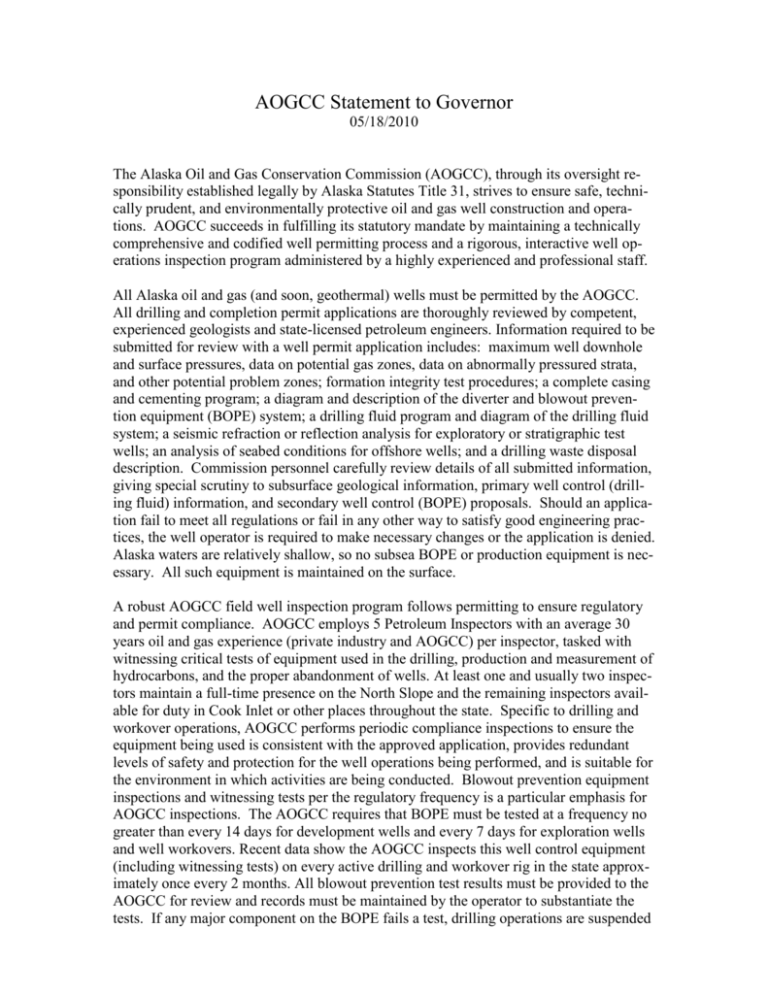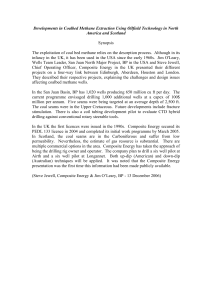We attach this copy of a statement
advertisement

AOGCC Statement to Governor 05/18/2010 The Alaska Oil and Gas Conservation Commission (AOGCC), through its oversight responsibility established legally by Alaska Statutes Title 31, strives to ensure safe, technically prudent, and environmentally protective oil and gas well construction and operations. AOGCC succeeds in fulfilling its statutory mandate by maintaining a technically comprehensive and codified well permitting process and a rigorous, interactive well operations inspection program administered by a highly experienced and professional staff. All Alaska oil and gas (and soon, geothermal) wells must be permitted by the AOGCC. All drilling and completion permit applications are thoroughly reviewed by competent, experienced geologists and state-licensed petroleum engineers. Information required to be submitted for review with a well permit application includes: maximum well downhole and surface pressures, data on potential gas zones, data on abnormally pressured strata, and other potential problem zones; formation integrity test procedures; a complete casing and cementing program; a diagram and description of the diverter and blowout prevention equipment (BOPE) system; a drilling fluid program and diagram of the drilling fluid system; a seismic refraction or reflection analysis for exploratory or stratigraphic test wells; an analysis of seabed conditions for offshore wells; and a drilling waste disposal description. Commission personnel carefully review details of all submitted information, giving special scrutiny to subsurface geological information, primary well control (drilling fluid) information, and secondary well control (BOPE) proposals. Should an application fail to meet all regulations or fail in any other way to satisfy good engineering practices, the well operator is required to make necessary changes or the application is denied. Alaska waters are relatively shallow, so no subsea BOPE or production equipment is necessary. All such equipment is maintained on the surface. A robust AOGCC field well inspection program follows permitting to ensure regulatory and permit compliance. AOGCC employs 5 Petroleum Inspectors with an average 30 years oil and gas experience (private industry and AOGCC) per inspector, tasked with witnessing critical tests of equipment used in the drilling, production and measurement of hydrocarbons, and the proper abandonment of wells. At least one and usually two inspectors maintain a full-time presence on the North Slope and the remaining inspectors available for duty in Cook Inlet or other places throughout the state. Specific to drilling and workover operations, AOGCC performs periodic compliance inspections to ensure the equipment being used is consistent with the approved application, provides redundant levels of safety and protection for the well operations being performed, and is suitable for the environment in which activities are being conducted. Blowout prevention equipment inspections and witnessing tests per the regulatory frequency is a particular emphasis for AOGCC inspections. The AOGCC requires that BOPE must be tested at a frequency no greater than every 14 days for development wells and every 7 days for exploration wells and well workovers. Recent data show the AOGCC inspects this well control equipment (including witnessing tests) on every active drilling and workover rig in the state approximately once every 2 months. All blowout prevention test results must be provided to the AOGCC for review and records must be maintained by the operator to substantiate the tests. If any major component on the BOPE fails a test, drilling operations are suspended until it passes. AOGCC data show a component pass rate of 98 percent1 for blowout prevention equipment. Since Prudhoe Bay Field was discovered in 1968 there have been seven blowouts from the 5000 wells drilled on the North Slope. The last one was in 1994. All except one were the result of loss of control within shallow gas zones. Since 1962, there have been four offshore blowouts in Cook Inlet, the last in 1987. All were from loss of control in shallow gas zones. None of the blowouts on the North Slope and Cook Inlet has resulted in injuries or oil spills. Subsequently with improvement in seismic acquisition and increased regulatory requirements, the risk of blowout from shallow gas has been greatly reduced. After well drilling and completion, upon and after the onset of well production operations, other AOGCC regulations require installation, use, and maintenance of safetyrelated well hardware such as surface safety valves for certain types of wells, subsurface safety valves for certain wells, and various well production flow control devices. All offshore wells require an automatic, fail-safe surface safety valve. A subsurface safety valve is required in every offshore producing well unless the operator can demonstrate to the AOGCC’s satisfaction that the well is incapable of unassisted flow of hydrocarbons to surface. The components of a well safety valve system are regularly inspected by AOGCC for proper operation given the production characteristics of the well and the challenges of operating environment, including witnessing tests. Operators are required to test of the components of a safety valve system at least once every 6 months and provide all test results to the AOGCC for review. The AOGCC inspection frequency increases on poor performing wells. AOGCC data shows an overall component pass rate of 96.3 percent for well safety valve systems in Alaska.2 Mechanical integrity testing of injection wells is another witnessed activity by the AOGCC. Operators are required to perform pressure tests on injection wells at a frequency specified by the AOGCC in an injection order specific to each well or field to ensure any injected fluids for enhanced oil recovery or waste disposal are confined to the injection interval and injection activities are protective of subsurface fresh water sources. AOGCC data shows an overall pass rate of 91.9 percent for injection well integrity tests.3 Proposed well workover procedures are also examined in detail by AOGCC reviewers, paying close attention to primary and secondary well control issues. Inspections of workover operations receive the same scrutiny by AOGCC as do drilling activities. Performance is captured in the statistics reported above for drilling. AOGCC engineers and geologists review proposed well abandonment activities to confirm all hydrocarbons and fresh water are confined to their respective indigenous formations and are prevented from migrating into other formations or to the surface. Inspectors witness activities such as the placement and testing of the plug for compliance with the approved permit and the final surface abandonment of the well (includes confirming 1 AOGCC Annual Performance Reports; FY2004 through FY2009 AOGCC Annual Performance Reports; FY2004 through FY2009 3 AOGCC Annual Performance Reports; FY2004 through FY2009 2 cement to surface in all casing annuli, proper cut-off depth, installation of marker plate, and burial). Failure to comply with AOGCC regulations results in one or more of the following enforcement actions: increased testing and oversight; restricted operations; notice of violation (with timeframe for corrective actions); civil penalty; or criminal penalty. All deficiencies found during AOGCC inspections or reviews of operator reports must be corrected. Examples of enforcement actions include a $400,000 fine and corrective actions for failure to test safety valve systems on an offshore platform; $200,000 fine for failure to plug and abandon wells properly; $100,000 fine for failure to report a well integrity failure; cost recovery and corrective actions in conjunction with reporting obligations; several waste determinations; and numerous wells placed on increased testing frequencies due to poor performance. The AOGCC also addresses all allegations of non-compliance, including hiring an independent third party investigator to assist as appropriate. There are several recent examples of AOGCC efforts to strengthen its regulatory oversight, including revising blowout prevention equipment and well safety valve system regulations, expanding the use of past performance data in focusing inspection resources, and increasing the amount of a penalty that can be imposed by Statute.






